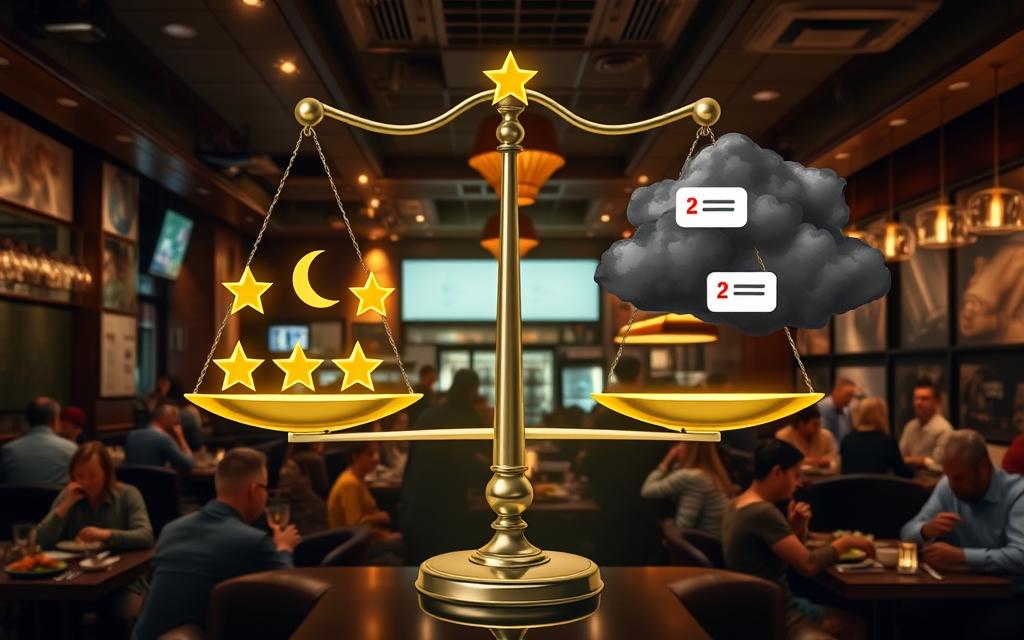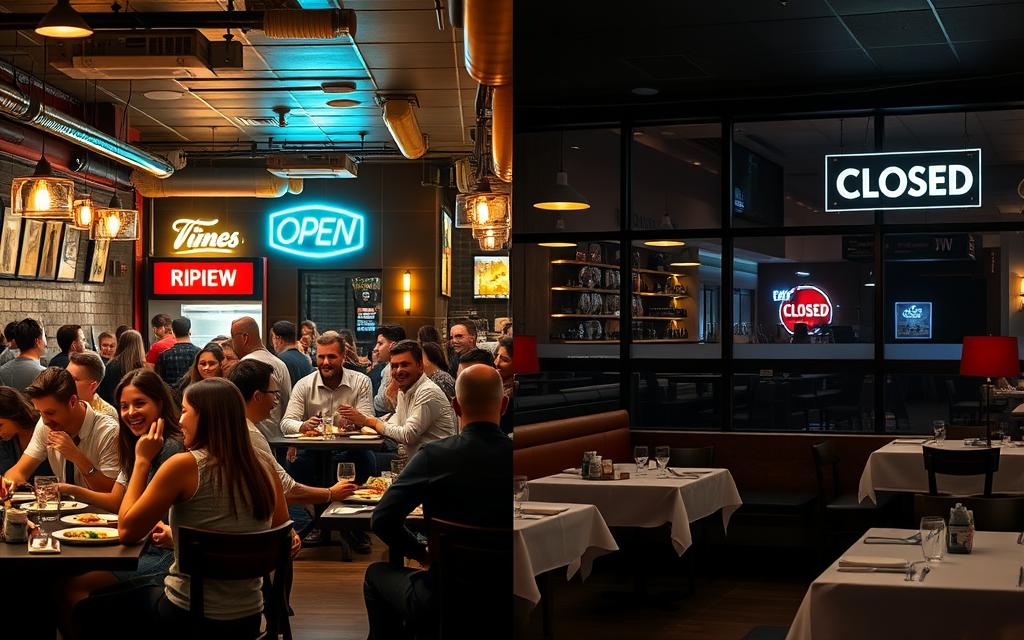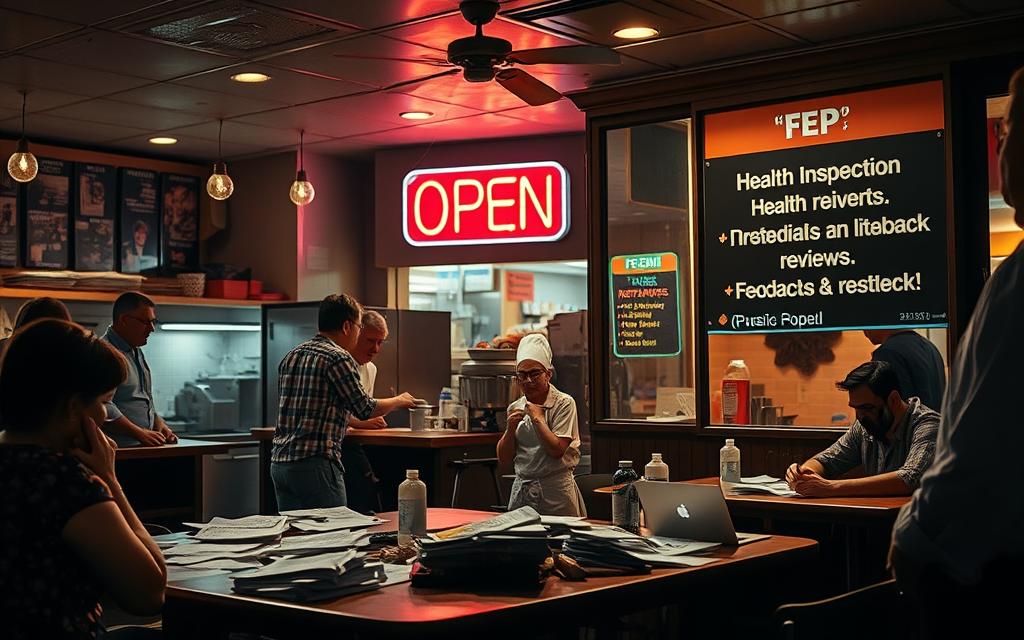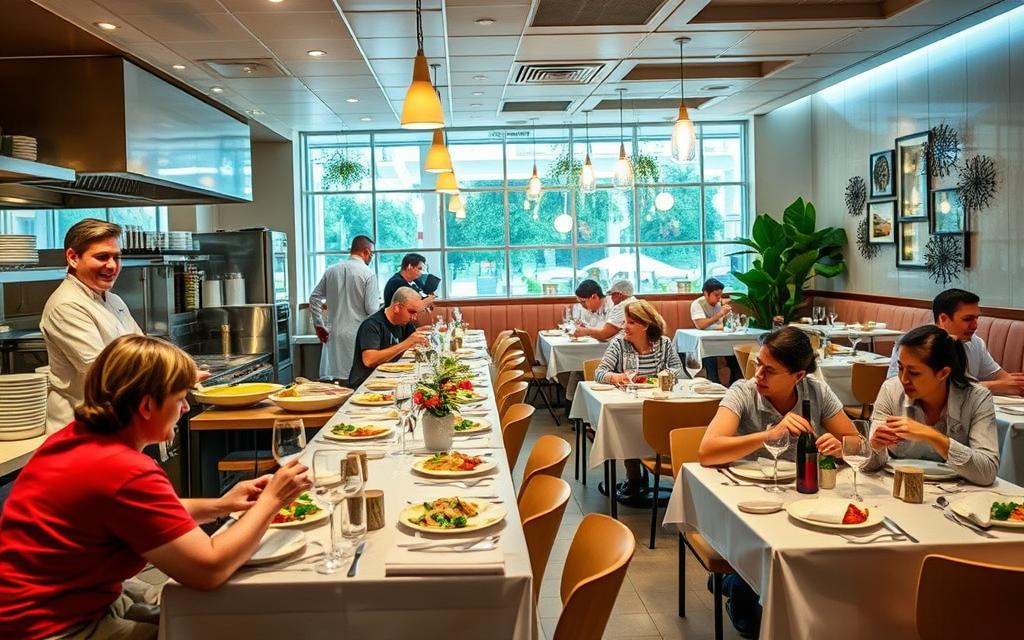Restaurants today face a big challenge in managing their online image. Sites like Yelp, Urbanspoon, and Google make it easy for feedback to spread fast. Bad reviews, failed health inspections, and employee slander can all hurt a restaurant’s reputation and sales. But, there are ways for restaurants to bounce back from these issues and improve their online image.
This article will talk about why online reputation matters for restaurants. It will also cover how to deal with negative reviews and manage online crises. Restaurants will learn how to keep an eye on their online image, use social media, and get help from reputation management services to boost their brand.
Key Takeaways
- Negative online reviews, failed health inspections, and employee slander can severely harm a restaurant’s reputation and bottom line.
- Effective reputation management strategies are crucial for restaurants to recover from these crises and rebuild their online presence.
- Restaurants must actively monitor their online reputation, leverage social media, and utilize professional reputation management services.
- Responding constructively to negative reviews and addressing customer concerns can help turn a crisis into an opportunity to improve operations.
- Understanding legal considerations around defamation and customer reviews is essential for restaurants to protect their brand.
The Importance of Online Reputation for Restaurants
In today’s digital world, a restaurant’s online image is key to its success. Online reviews and ratings greatly influence where people choose to eat. Over one-third of customers say online reviews shape their dining choices.
Questions already? Ask for a free consultation.
Millennials and frequent diners are especially influenced by online reviews. Over 50% of them say reviews impact their restaurant picks. A single negative review can hurt a restaurant’s sales and bookings, with one study showing a loss of up to 22% of potential customers.
On the other hand, positive reviews and high ratings can boost bookings and visibility. Restaurants with 4+ star ratings on sites like Google, Yelp, and TripAdvisor gain credibility. They attract new customers seeking a reliable dining experience.
| Statistic | Impact |
|---|---|
| 88% of consumers incorporate reviews into their purchasing decisions | Trusting online reviews as much as personal recommendations |
| Increasing your overall star rating by even one star | Can lead to as much as a 9% increase in revenue |
| 94% of diners say that an online review has convinced them to avoid a restaurant | Due to negative reviews |
The role of review sites in the restaurant industry is huge. Restaurants that quickly respond to reviews and engage with customers online tend to have higher ratings. Managing a restaurant’s online presence is vital for a good reputation and attracting new customers.
“Positive reviews, high ratings, and engaging social media profiles can lead to more bookings via online platforms like OpenTable, Zomato, or Resy.”

In conclusion, a restaurant’s online reputation is crucial. They must actively manage their digital presence, respond to reviews, and use social media. This ensures a positive online image and attracts the diners needed for success.
The Impact of Bad Reviews on Restaurant Revenue
The digital age has changed how we make choices, especially when it comes to food. Online reviews play a huge role in deciding where to eat. In fact, 97% of people look for reviews before buying or trying something new. And 93% say reviews help them make up their minds.
Harvard Study on Yelp Ratings and Revenue
Harvard Business School did a study on Yelp and restaurant money. They found that a higher Yelp rating means more money for independent restaurants. A one-star increase could bring in 5-9% more cash.
Even big chain restaurants see a small gain from better Yelp ratings. They might make 1-3% more money with just one more star.
But it’s not just Yelp. Bad reviews on any site can hurt a restaurant’s profits a lot. Fake negative reviews can cut revenue by up to 20%. On the other hand, good and detailed reviews can sway customers more than just stars.
| Impact of Yelp Ratings on Revenue | Independent Restaurants | Chain Restaurants |
|---|---|---|
| 1-star rating increase | 5-9% revenue increase | 1-3% revenue increase |
Managing your restaurant’s online image is key to making more money. Reviews are a big deal for diners. In fact, 62% of people think reviews are the most important thing when choosing a restaurant. And 34% pick a place to eat just because of online reviews.

The digital world keeps changing, and so does the need for restaurants to manage their online image. Knowing how bad reviews affect your money is important. By acting fast to fix these issues, restaurants can stay ahead in a tough market.
Online Reputation Management Strategies
As a restaurant owner, keeping a strong online reputation is key. It helps attract new customers and keep the ones you have. Most diners check online reviews before deciding where to eat.
Start by claiming and optimizing your listings on sites like Yelp, Urbanspoon, TripAdvisor, and Google. Make sure your business info, like hours and menu, is correct. This builds trust and makes it easier for people to find you.
- Claim and optimize your listings on key review sites: Ensure accurate business information is displayed and take control of your online profiles on sites like Yelp, Urbanspoon, TripAdvisor, and Google.
- Monitor and respond to online reviews: Regularly check for new reviews, both positive and negative, and address them in a timely and professional manner. A thoughtful response can turn a negative review into a positive interaction.
- Encourage satisfied customers to leave reviews: Proactively ask your happy customers to share their dining experiences online, as positive reviews can significantly boost your restaurant’s reputation.
- Analyze review data and sentiment: Use reputation management tools to track and analyze the sentiment of your online reviews, allowing you to identify areas for improvement and address any recurring issues.
- Leverage social media: Maintain an active presence on platforms like Facebook, Instagram, and Twitter to engage with your customers, share updates, and showcase your restaurant’s unique offerings.
By using these strategies, you can manage your restaurant’s online image. This can lead to more customers and higher profits.
“Reputation is an idle and most false imposition; oft got without merit, and lost without deserving.” – William Shakespeare

In today’s digital world, your restaurant’s online image is crucial. By actively managing your online presence, you can stay ahead. This helps make your restaurant a top choice in your area.
Responding to Negative Reviews
Getting negative reviews is part of running a restaurant. But how you respond matters a lot. Quick and helpful responses show you care about your customers’ experiences.
Guidelines for Constructive Responses
- Act quickly: Reply to negative reviews fast, within 24-48 hours. This shows you value their feedback and are ready to fix problems.
- Personalize your response: Don’t use generic replies. Talk to the customer by name and tackle their specific issues. This shows you’ve listened and care.
- Offer a solution: Suggest a way to fix the problem, like a refund or a discount. This shows you’re serious about making things right.
- Remain professional: Keep your cool, even with tough feedback. Stay polite and respectful. Focus on finding a solution that works for both sides.
- Learn from the feedback: Look for good points in the review. Use them to improve your service and dining experience.
By following these tips, you can turn bad reviews into chances to improve. A good response can change a customer’s mind.
“45% of consumers say they’re more likely to visit a business that responds to negative reviews.” – 2022 ReviewTrackers survey

Crisis Communications for Major Incidents
In the fast-paced world of the restaurant industry, small problems can quickly turn into big crises. These crises can harm a business’s reputation and profits. Restaurants must be ready to act fast and effectively to protect their online image. Creating a detailed crisis management plan is key. It should outline how to handle different types of incidents.
California Pizza Kitchen (CPK) is a great example of handling a crisis on social media. A customer’s TikTok video about a food issue went viral, getting over 4.5 million views. CPK responded with kindness and honesty. They apologized, offered free food, and said they were retraining staff. This approach helped them control the situation.
Keeping control of your brand’s story is vital during a crisis. Social listening tools are very helpful. They let brands watch what people are saying in real-time. This helps them understand opinions, compare to competitors, and respond quickly. All these steps help strengthen their crisis communication plans.
“Costs of cyber crimes in the technology industry are expected to reach $9.22 trillion in 2024 and rise to $13.82 trillion in 2028, underscoring the importance of crisis communication in this sector.”
Crisis communication is not just for restaurants. It’s also crucial in banking, finance, and healthcare. These industries need to keep things confidential and open. Media training for important people and having a crisis plan are key. They help deal with public relations crises and keep trust with everyone.
Being able to quickly, openly, and kindly handle big issues can save a restaurant’s online image. By being alert, planning ahead, and using social listening, restaurants can protect their brand. They can even come out stronger after tough times.

Learning from Other Restaurants’ Crises
In the fast-paced world of restaurants, crises can happen to anyone. By looking at what others have gone through, owners can learn and get ready for anything. Let’s dive into some big restaurant crises and what we can learn from them.
The Domino’s Pizza Video Scandal (2009)
In 2009, two Domino’s employees made a video showing bad food handling. It quickly spread online. Domino’s acted fast, firing the employees and talking about it in a video from their president. They showed they cared about food safety, helping to keep customers.
Spice Haven’s Ingredient Quality Controversy
Spice Haven, a trendy spot, lost customers after a false online post about their ingredients. They bought insurance for online crises and fixed their quality control. This shows how important it is to be ready for problems.
Sizzle Street Grill’s Negative Review Challenge
Sizzle Street Grill, a local BBQ place, got famous on Instagram for their food. But, a bad review from a famous person hurt their image. Luckily, their insurance helped them deal with it and improve.
These stories show how key quick and honest talking, being ready for problems, and using insurance are. By learning from others, restaurants can plan better for crises and come out even stronger.
| Restaurant | Incident | Response | Outcome |
|---|---|---|---|
| Domino’s Pizza | Video of unsanitary food preparation | Fired employees, addressed issue directly | Mitigated damage, restored customer trust |
| Spice Haven | Misleading viral post about ingredient quality | Invested in reputational risk insurance, improved quality control | Bounced back, strengthened operations |
| Sizzle Street Grill | Negative review from social media influencer | Leveraged reputational risk insurance coverage | Weathered the storm, focused on improving |
By being proactive about their online image, restaurants can handle crises well. It’s important to stay alert, talk openly, and learn from others to protect their reputation and succeed in the long run.
Restaurant Online Reputation Monitoring
In today’s digital world, your restaurant’s online image is key. People check out Yelp, Urbanspoon, TripAdvisor, and Google Reviews before choosing where to eat. Social media sites like Facebook, Twitter, and Instagram also shape how people see your brand.
It’s vital to keep an eye on your online presence to keep a good reputation. With help from reputation management services, you can control how you appear online. This ensures your restaurant looks great to potential customers.
- Comprehensive monitoring of review sites, social media, and local directories to identify and address any negative reviews or mentions
- Timely and constructive responses to customer feedback, demonstrating your commitment to providing an exceptional dining experience
- Generating positive reviews by incentivizing happy customers to share their experiences online
- Maintaining a strong social media presence, engaging with your audience, and showcasing your restaurant’s unique offerings
- Providing detailed reputation reports with actionable insights to help you make informed decisions about your business
Working with a trusted reputation management service keeps you ahead. It protects your brand and boosts your search rankings. This leads to more loyal customers and a healthier bottom line for your restaurant.
In today’s digital age, your restaurant’s online image is priceless. Invest in the right tools and strategies to manage your online presence. Watch your business grow in the changing world of dining and hospitality.
The Role of Social Media
Social media is now a key tool for restaurants to connect with customers and manage their online image. As social media’s power grows, smart restaurant owners use it to increase visibility, draw in new customers, and handle customer issues well.
Best Practices for Restaurant Social Media
To get the most from social media, restaurants should follow these best practices:
- Maintain an Active Presence: Post updates, photos, and content often to keep your brand in customers’ minds. Almost 60 percent of the world uses social media (SmartInsights). Also, nearly 80 percent say social media affects their buying choices (Forbes).
- Showcase Your Culinary Creations: Share high-quality photos and videos of your dishes to spark interest and draw in new customers. People trust products with about 40 reviews (FinancesOnline).
- Promote Specials and Events: Advertise special offers, discounts, and events on social media to attract and keep customers.
- Respond to Feedback: Watch your social media for reviews and comments, and reply quickly. People like to shop with businesses rated over 3.3 stars (Search Engine Journal).
- Adapt to Trends: Keep up with the latest social media trends and customer likes. Adjust your strategy to stay ahead in the industry.
By following these practices, restaurants can use social media to improve their online image, engage customers, and increase profits.
“Social media presence is crucial for restaurants, as it influences where people seek restaurant recommendations and influences their dining decisions.” – Goyal (2016)
| Social Media Platform | Key Benefits for Restaurants |
|---|---|
| Visually-appealing platform to showcase food and ambiance | |
| Effective for promoting events, special offers, and customer engagement | |
| TikTok | Opportunity to create fun, viral content and connect with a younger audience |
Legal Considerations for Online Reviews
Restaurants face a complex world of online reviews and reputation management. Positive feedback can help, but dealing with false statements is tricky. It’s key to know the legal side of online reviews to protect your restaurant’s image and rights.
The Consumer Review Fairness Act of 2016 protects customers from being punished for negative reviews. It stops businesses from using contracts to silence critics. But, restaurants can still fight back against false or harmful reviews.
Restaurants might be able to sue for defamation in some cases. But, courts often favor free speech over lawsuits. Businesses need to prove the reviews were false and hurt their business. It’s wise to talk to a lawyer before taking legal action.
Online reputation management services can help with these issues. They can watch your online presence, handle negative reviews, and follow the law. Being proactive and informed can help protect your brand and build trust with customers.
The laws around online reviews are changing, and restaurants need to stay alert. By balancing protecting their reputation with respecting reviewers’ rights, restaurants can overcome challenges. This way, they can grow stronger and better serve their communities.
The Benefits of Positive Online Reputation
In today’s world, a restaurant’s online image is key to its success. A good online presence can bring many benefits, like more money and loyal customers. Let’s see how a positive online image can change your restaurant’s luck.
Studies show online reviews really matter for a restaurant’s success. Harvard found that a one-star increase on Yelp can boost revenue by 5-9%. Good reviews mean more people want to eat there, making it hard to get a table.
But it’s not just about money. A great online image also cuts down on marketing costs. Happy customers become your best promoters.
Social media is important for your online image. By talking to your customers on Facebook and Instagram, you can show off your restaurant. Sharing customer photos and working with influencers can help make your image better.
It’s crucial to watch and reply to all reviews, good and bad. Bad reviews might seem tough, but they’re a chance to show you care. Responding well to negative reviews can turn them into positives.
In the end, a good online image is a big advantage. By listening to feedback, using social media, and giving great service, you can win over more customers. This will help your restaurant grow and attract new people to try your food.
Turning Negatives into Positives
In the competitive restaurant world, managing your online image is key. Negative reviews can be tough, but smart owners see them as chances to improve. By looking at reviews, you can spot common issues and fix them.
Using Feedback to Improve Operations
Negative reviews often point out service, food, or cleanliness problems. These are great chances to get better. Quickly address complaints, say sorry, and offer to fix it. This shows you care and might even win back a customer.
- Analyze review data to identify common themes or recurring problems
- Use constructive criticism to enhance service, food quality, and overall operations
- Respond to negative reviews quickly, apologize sincerely, and offer solutions
- Convert negative experiences into positive ones by providing something of value, such as discounts or complimentary services
Even top restaurants get bad reviews sometimes. The trick is to handle them well and use them to get better. By listening to customers, you can improve, make guests happier, and boost your online image. This is vital in today’s digital world.
“Negative reviews can provide valuable insights for improving business operations. Addressing them promptly and offering solutions can help turn negative feedback into positive outcomes.”
| Statistic | Percentage |
|---|---|
| Diners who choose restaurants based solely on online information | 34% |
| 18- to 34-year-olds who say online reviews play an important role in dining decisions | 53% |
| Consumer feedback on retailer online listings that goes unanswered | 54% |
| Average number of days for brands to respond to reviews on Google in 2023 | 6.3 days |
Reputation Management Services
In today’s digital world, your restaurant’s online image is key to success. Over 60% of people check reviews before they go out to eat. Reputation management services help you manage your online image and turn bad feedback into chances for growth.
These services watch reviews on sites like Yelp, Google, and social media. They use special tools to send you updates on new reviews. This way, you can quickly respond to any issues and keep your restaurant’s rating high.
| Service Offering | Key Benefits |
|---|---|
| Review Monitoring | Automated tracking and analysis of reviews, with personalized response recommendations |
| Social Media Management | Proactive engagement with customers on platforms like Facebook, Instagram, and Twitter |
| Loyalty Programs | Customizable SMS and email campaigns to boost customer retention and increase revenue |
| Reputation Reporting | Detailed analytics and insights to track your online visibility and make informed decisions |
Effective reputation management means quick, personal responses and a real commitment to making customers happy. By facing negative reviews and using positive ones, you show your restaurant’s commitment to quality.
Spending about $100 a month on a good reputation service is worth it. It can lead to more customers, better ratings, and more success. It’s a small cost for the peace of mind and competitive edge a great online image brings.
“Responding to negative reviews is crucial, but it’s just as important to engage with your satisfied customers. A personalized ‘thank you’ can go a long way in building loyalty and brand advocacy.”
Preventative Best Practices
To keep your online reputation shining, take proactive steps to avoid risks. One key step is to offer top-notch customer service. A great dining experience can lower the chance of bad reviews, which harm your reputation.
Also, watch out for threats like phishing and credit card fraud. These can hurt your guests’ data security. Use strong security, like two-factor authentication, and check your systems often to keep data safe.
Creating a good work environment and keeping your team is vital. With high staff turnover, focus on employee growth and a supportive culture. This keeps your team united and stops problems from getting out.
Keep an eye on your online presence on sites like Yelp, Google My Business, Facebook, TripAdvisor, Zomato, OpenTable, and Uber Eats. Quick responses to reviews show you care about your customers. This can lessen the blow of bad feedback.
“The most effective way to protect your restaurant’s reputation is to prevent issues from arising in the first place. By prioritizing exceptional customer service, data security, and employee engagement, you can build a strong foundation that withstands any potential challenges.”
By taking a comprehensive approach to reputation management, your restaurant can stay positive online. This boosts credibility and builds trust with your customers.
Leveraging Technology and Data
In today’s world, using technology and data is key to managing your reputation. By combining customer feedback, sales data, and operational metrics, you can spot and fix problems early.
It’s also important to check your vendors and make sure guest data is safe. This keeps your reputation intact by avoiding data breaches.
| Key Preventative Practices | Benefits |
|---|---|
| Delivering exceptional customer service | Reduces the likelihood of negative feedback and improves customer satisfaction |
| Implementing robust data security protocols | Protects customer information and prevents data breaches |
| Fostering a positive work environment | Reduces staff turnover and helps maintain a cohesive team |
| Proactively managing online reviews | Demonstrates commitment to customer satisfaction and mitigates the impact of negative feedback |
| Leveraging technology and data | Provides valuable insights to identify and address potential issues proactively |
By following these best practices, your restaurant can build a strong, positive online reputation. This is the foundation for your business’s success in the long run.
Conclusion
In today’s digital world, managing your online reputation is key for any restaurant’s success. By keeping an eye on your online presence, you can handle both good and bad reviews well. This helps improve your restaurant’s image and draws in more customers.
Remember, managing your online reputation is a constant task. It needs you to be alert and ready to change. Use the newest trends and best practices to stay ahead. Also, don’t forget the importance of happy customers and their online reviews.
In the ever-changing restaurant world, a strong online reputation is a big plus. It helps you stand out and keep loyal customers. By focusing on good online reputation management, your restaurant can thrive. You’ll make your customers happy, both online and in person.

